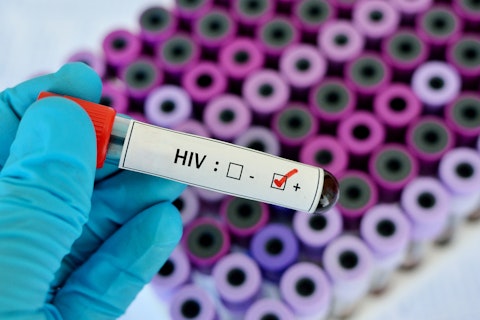In this article, we will be taking a look at the 20 countries with the highest rate of AIDS. If you are not interested in reading the details, head straight to the 5 Countries With Highest Rates of AIDS.
AIDS, or Acquired Immunodeficiency Syndrome, remains a pressing global health concern, and its impact varies significantly across nations. In this discussion, we delve into the sobering topic of countries with the highest rates of AIDS. Despite remarkable progress in combating the HIV epidemic, certain regions face alarming prevalence rates, amplifying the urgency of comprehensive prevention, treatment, and awareness efforts.
By exploring the current epidemiological landscape, identifying key contributing factors, and evaluating the strategies implemented to address the crisis, we aim to shed light on these countries’ challenges and underscore the importance of international collaboration in tackling this devastating disease.
Introduction to the AIDS Epidemic: Understanding the Global Impact
The AIDS epidemic has significantly impacted the world, affecting millions of people. It first emerged in the 1980s and has since spread to all parts of the world. Despite significant progress in treatment and prevention, it remains a major global health challenge. According to the World Health Organization, approximately 39 million people lived with HIV in 2022, and 630,000 died from AIDS-related illnesses that year.
The epidemic’s economic impact has also been substantial, with an estimated $7.9 billion spent on AIDS-related healthcare in low- and middle-income countries in 2019. Understanding the epidemic’s effects is crucial to developing effective strategies to combat it. Factors such as stigma, discrimination, poverty, and lack of access to healthcare have all contributed to the spread of the disease.
Education and awareness campaigns have played a crucial role in reducing new infections, but much more needs to be done to address the root causes of the epidemic. Ultimately, it is only through a collective effort that we can hope to end the AIDS epidemic and ensure everyone has access to the care and support they need.
Factors Contributing to High HIV/AIDS Rates: Socioeconomic, Cultural, and Healthcare Factors
High HIV/AIDS rates are a complex issue that can be attributed to various factors such as socioeconomic, cultural, and healthcare factors. According to the World Health Organization (WHO), poverty, lack of education, and unemployment are some of the socioeconomic factors that can contribute to the spread of HIV/AIDS. In fact, WHO reports that in low- and middle-income countries, people living in poverty are twice as likely to contract HIV/AIDS as those not. Cultural factors such as stigma and discrimination can also contribute to high HIV/AIDS rates.
The Joint United Nations Programme on HIV/AIDS (UNAIDS) reports that stigma can prevent individuals from seeking testing, treatment, and care, leading to a higher risk of transmission. Discrimination against certain groups, such as men who have sex with men, sex workers, and people who use drugs, can also contribute to the spread of HIV/AIDS. Healthcare factors such as limited access to testing, treatment, and care can also contribute to high HIV/AIDS rates.
According to UNAIDS, lacking knowledge and resources can prevent individuals from accessing the necessary care. Additionally, fear of discrimination from healthcare providers can prevent individuals from seeking care. In fact, UNAIDS reports that globally, only 76% of people living with HIV/AIDS have access to antiretroviral therapy. In order to address the issue of high HIV/AIDS rates, it is essential to address these various factors, which can include increasing access to healthcare, reducing stigma and discrimination, and providing education and resources to prevent the spread of the disease.
According to reports, the U.S. government spends $28 billion per year on federal domestic HIV/AIDS programs. By addressing these issues and investing in prevention and treatment programs, we can work towards reducing HIV/AIDS rates and improving the health and well-being of individuals and communities affected by the disease.
Corporate Social Responsibility (CSR) and HIV/AIDS: Business Contributions to the Cause
Corporate Social Responsibility (CSR) is crucial for businesses, integrating social and environmental concerns into their operations. One area where companies can significantly impact is combating HIV/AIDS, a global pandemic with devastating consequences. Additionally, businesses can contribute through employee programs, such as education, training, testing, counseling, and support for those living with the disease. By taking action, businesses can play a vital role in the fight against HIV/AIDS and positively impact affected individuals and communities.
Innovation in HIV/AIDS Research: Advancements and Challenges
Innovation in HIV/AIDS research has come a long way since the epidemic’s early days. According to recent financial statistics, the global market for HIV/AIDS drugs was valued at $30.46 billion in 2021 and is projected to reach $45.58 billion by 2028, which is a testament to the significant advancements that have been made in treating this disease.
Advancements in the treatment of AIDS have indeed come a long way in recent years, thanks to the tireless efforts of several breakthrough companies and the development of new medications. These companies have invested significantly in research and development, which has led to the discovery of powerful tools in the fight against AIDS.
For instance, Truvada, a breakthrough medication that is a combination of two antiretroviral drugs, has been shown to significantly reduce the risk of HIV transmission. Gilead Science, Inc. (NASDAQ:GILD), one of the most profitable pharmaceutical companies in the world, has generated over $19.5 billion in revenue on Truvada since its approval in 2012.
Speaking of Gilead Sciences, Inc. (NASDAQ:GILD) the company has developed a number of medications that have revolutionized AIDS treatment. In 2022 alone, Gilead Sciences, Inc. (NASDAQ:GILD) reported a revenue of $27.3 billion, with a net income of $4.5 billion, which underscores the importance of investing in research and development to find new ways to combat the virus and improve the lives of those affected.
Merck & Co., Inc. (NYSE:MRK) and ViiV Healthcare are also making significant contributions to AIDS treatment. Merck & Co., Inc. (NYSE:MRK)’s Delstrigo and ViiV Healthcare’s Cabenuva have turned out to be affective HIV medications. Merck & Co., Inc. (NYSE:MRK) and ViiV Healthcare play an important role in AIDS treatment.

Jarun Ontakrai/Shutterstock.com
Our Methodology
For our list of the countries with the highest rates of AIDS, we relied on aggregated data by Statista and World Population Review and ranked the countries in ascending order of high rate of AIDS among populations aged 15-49 as of 2021.
Here is the list of the 20 countries with the highest rate of AIDS.
20. Cote Dlvoire
AIDS Rate: 1.9%
AIDS is a significant issue in Cote D’Ivoire, with an estimated 1.9% prevalence among adults aged 15-49, higher than the sub-Saharan Africa average. The disease’s impact on daily life includes various health problems and management difficulties. Economically, AIDS leads to lost productivity and increased healthcare costs. Nevertheless, efforts to improve HIV testing and treatment access offer hope for reducing the disease’s impact over time.
19. South Sudan
AIDS Rate: 2.1%
AIDS is a significant health concern in South Sudan, with approximately 170,000 people affected. The disease substantially impacts daily life, making work and family care challenging due to physical and emotional symptoms. High treatment costs lead to limited access, worsening symptoms, and overall health. The economic toll is considerable, with AIDS resulting in lost productivity and increased healthcare expenses. The government and international organizations focus on improving access to affordable treatment, prevention measures, and education to combat the issue.
18. Rwanda
AIDS Rate: 2.3%
In Rwanda, AIDS is a severe issue, impacting over a quarter million people. The disease’s cost is high, despite government programs for awareness, prevention, and treatment. Many living with HIV/AIDS can’t work, resulting in lost income and reduced productivity. However, Rwanda is progressing in the fight against AIDS with continued efforts and support.
17. Central African Republic
AIDS Rate: 2.7%
In the Central African Republic, the AIDS epidemic is a significant concern, with around 120,000 people living with HIV. The disease’s impact is profound, leading to ostracization, limited healthcare access, and economic discrimination. Treating AIDS turn out to be very costly, straining the country’s limited resources and struggling economy. Collaborative efforts between the government and international organizations are crucial to increase prevention and treatment access, reduce stigma, and support those affected, working towards ending the AIDS epidemic.
16. Cameroon
AIDS Rate: 2.9%
AIDS affects thousands of people in Cameroon, especially marginalized groups like sex workers and homosexual males. Social stigma and discrimination hinder healthcare access for those living with AIDS. The disease places a heavy economic burden on the healthcare system due to high treatment costs. The government has addressed the crisis by improving healthcare access and reducing stigma. However, more support is needed to combat the disease’s spread. In 2022 Cameroon had 480,000 people living with AIDS, with 35,000 new infections.
15. Gabon
AIDS Rate: 3%
Just like other countries, Gabon also stands among the countries with the highest rate of AIDS, with around 25,000 people living with the disease, particularly among sex workers and gays. The disease’s impact includes stigma, discrimination, and severe health consequences. Economically, treating AIDS strains the country’s resources, posing challenges for affordability.
14. Guinea – Bissau
AIDS Rate: 3.1%
AIDS affects about 3.1% of Guinea – Bissau’s population aged 15-49. Daily life for those with AIDS is impacted by discrimination and high treatment costs. The disease also poses significant economic consequences, with decreased productivity and increased healthcare expenses. However, the government and NGOs are actively working on prevention and treatment programs to combat the spread of HIV/AIDS and support those affected.
13. Equatorial Guinea
AIDS Rate: 3.3%
AIDS affects around 63,000 people in Equatorial Guinea. The disease takes a toll on their daily life physically and emotionally. Efforts are underway to combat HIV/AIDS, including awareness campaigns and treatment access programs. However, there is still much to be done in the fight against this devastating disease.
12. Congo
AIDS Rate: 3.8%
Congo is another one of the countries with highest rates of HIV Infections, with over 1.2 million people living with HIV/AIDS, representing a prevalence rate of around 3.8%. The disease profoundly impacts daily life, making work and activities challenging due to health complications and facing discrimination. Economically, AIDS costs the country billions of dollars annually, with high treatment expenses and lost productivity. Treating AIDS is a significant challenge, with antiretroviral drugs often being prohibitively expensive for many, despite efforts by the government and international organizations to provide access.
11. Kenya
AIDS Rate: 4%
AIDS is a significant health concern in Kenya, affecting approximately 1.5 million people. Due to stigma, the disease takes a toll on their daily lives, with physical, emotional, and social challenges. Economically, treating AIDS costs up to $20 per person per month, which makes it $224 annually, straining the healthcare system and budget. However, education, awareness campaigns, and increased testing and treatment access are making a positive difference in combatting the spread of AIDS in Kenya.
10. Tanzania
AIDS Rate: 4.5%
Tanzania has around 1.7 million people living with AIDS. The disease’s impact is immense, leading to discrimination, health complications, and limited access to healthcare. Economically, AIDS results in high treatment costs, lost productivity, and reduced economic growth. While some programs offer free or low-cost antiretroviral therapy, treatment expenses remain a significant burden, especially for remote areas with limited healthcare services.
9. Uganda
AIDS Rate: 5.2%
AIDS is a severe health issue in Uganda, affecting about 1.4 million people with widespread discrimination and stigma. Economically, treating the disease is burdensome, costing approximately $258.78 per person, straining the healthcare system. However, efforts are underway to combat HIV/AIDS, including improved testing and treatment access and awareness campaigns to reduce stigma.
8. Malawi
AIDS Rate: 7.7%
AIDS is a significant health concern in Malawi, with an estimated 1.1 million people living with the disease. This high prevalence substantially impacts the daily lives of those affected, as they often face stigma and discrimination. It also significantly impacts the country’s economy, as the cost of treating AIDS can be very high. In Malawi, it is estimated that the cost of treating AIDS is around $330 per person per year. Despite these challenges, efforts are underway to combat the spread of AIDS in Malawi, including increased education and access to testing and treatment.
7. Zambia
AIDS Rate: 10.8%
In Zambia, around 53,000 people are affected by AIDS. Daily life for those with the disease involves managing symptoms and adhering to strict medication regimes. Economically, treating AIDS costs approximately $200 million annually, straining the country’s limited resources and hindering other development areas. Socially, AIDS leads to stigma and discrimination, impacting mental health and well-being. Addressing these challenges is vital to create a more inclusive and supportive society in Zambia.
6. Zimbabwe
AIDS Rate: 11.6%
Zimbabwe stands sixth among the countries with the highest rates of AIDS, with approximately 1.3 million people fighting with the disease. Stigma and discrimination make accessing healthcare and employment difficult for those living with the disease, impacting their daily lives and financial stability. Caring for a bedridden AIDS patient in the country for three months costs approximately $556-841 for the family. However, with access to antiretroviral therapy and support services, many individuals can manage the disease and lead productive lives. Addressing the root causes of the AIDS epidemic remains essential to ensure widespread access to care and support in Zimbabwe.
Click to see and continue reading the 5 Countries With Highest Rates of AIDS.
Suggested Article:
- 20 Countries with the Highest Rates of Skin Cancer.
- 25 Countries With Highest Rates of Obesity.
- 20 Countries With The Highest Rate Of Diabetes.
Disclosure. None: The 20 Countries With Highest Rates of AIDS is originally published on Insider Monkey.


